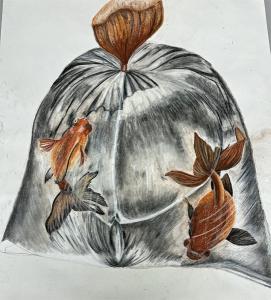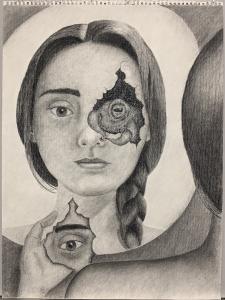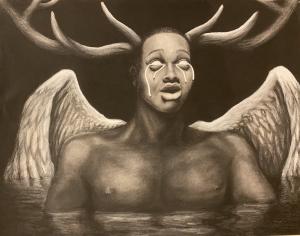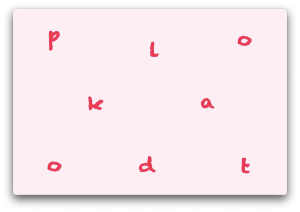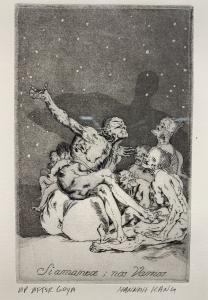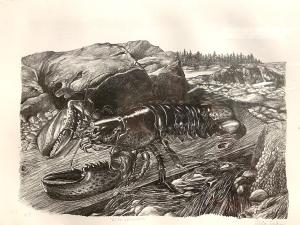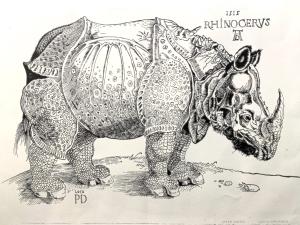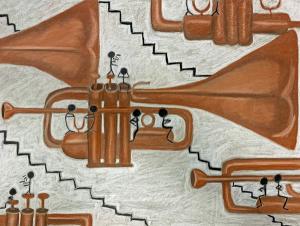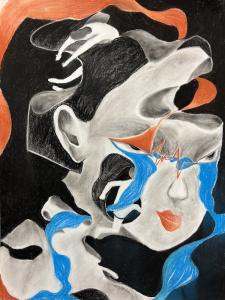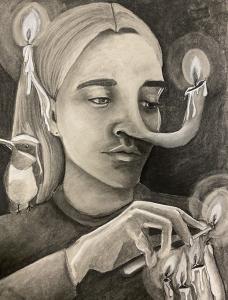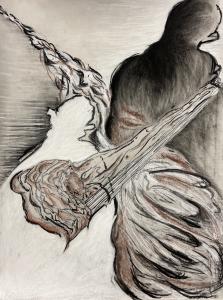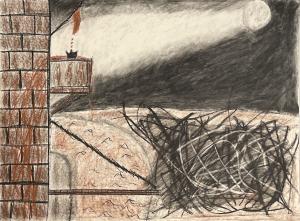Student artists pay tribute to those who have inspired them.
Paying homage to artists that have come before us is a time-honored practice in all forms of visual and performing art. Professional and aspiring artists pay tribute to those who have inspired them by referencing their work in transformative ways—and sometimes through more overt imitation. In academic settings, copying works created by master artists is a common pedagogical tool used to teach technique, best practices, and craftsmanship.
The works on exhibit here were created by Georgetown University students in Professor Scip Barnhart’s printmaking classes, Professor Elyse Kelly’s Intermediate Animation - ARTS 166 course, and Professor Thomas Xenakis’s Drawing I: Visual Language course. Some of Professor Xenakis’s students were inspired by an assignment titled: Interpretation of a Song: Value as Emotion. Other students responded visually to the Final Project prompt: Supersize it the Surreal Way. The students created Surrealist self-portraits to express their essence as an homage to the art movement Surrealism.
This student artwork complements the Art of Homage Exhibition currently on display on the 5th floor of Lauinger Library. As Art Curator LuLen Walker notes in her exhibition statement, “The central message is that no art is created in a vacuum, and all creators depend, to a greater or lesser degree, on their artistic predecessors.”
The Great Escape
Maggie Donahue
2022
Conte crayon on paper
This piece reflects the impact of human development on our world, specifically the ocean.
Also Zog Zarathustra
Cole Weese
2022
Conte crayon on paper
A visual representation of Richard Strauss's "Also Sprach Zarathustra," which itself was a musical response to Friedrich Nietzsche's book of the same title.
Breaking Open
Mirabai Sinha
2022
Charcoal pencils on paper
This piece focuses on the unsustainability of silence and internalization to demonstrate the danger of repressing feelings. The artist hoped to express that living honestly requires an engagement with imperfection and an embrace of small rebellions.
Fallen Angel
Terry Kyei
2022
Charcoal on paper
This piece was created using both black and white charcoal. This piece represents the feeling of failure and anguish. However, the image of the fallen angel demonstrates that failure does not define who you are. A fallen angel is still an angel who is ready to take flight again.
Polka Dance
Caterina Peracchi
2022
Kinetic typography animation with Adobe After Effects (Watch the video)
This pieces shows a play on the words of the various concepts entailing the works of Yayoi Kusama, a Japanese artist predominantly known for her installations of pumpkins and polka dot patterns. Multiple words taken either from descriptions of Kusama's pieces or her interviews are transformed into her characteristic polka dots with Adobe After Effects. The words range from the shared physical characteristics of Kusama's works, to the psychological elements that serve as motivation for her art.
Homage to Goya
Hannah Kang
2018
Etching with aquatint
Copy of Si amanece; nos Vamos by Francisco Goya originally created in 1797-1798.
WARNING: Objects in the Mirror
Juan Connelly
2022
Digital animation on Adobe After Effects (Watch the video)
I made this film as a reflective piece after studying for a month in South Africa. The film plays with the nature of mirrors as a form of reflection, distortion, and separation to comment on the racist history and generational burdens of South African society. I drew inspiration from the South African artist William Kentridge. He has some charcoal animations which blow me away every time I see them. I pay homage to his theme of generation burdens and his very limited use of color (in this case red).
Homage to Wengenroth
Aleta Looker
2018
Lithograph
Copy of Stow Wengenroth’s Lobster originally created in 1944.
Homage to Dürer
Piper Donaghu
2018
Lithograph
Copy of Albrecht Dürer’s Rhinoceros originally created in 1515.
Let's Call the Whole Thing Off
Julianne Bruggemann
2022
Conte crayon on paper
An art piece to accompany Ella Fitzgerald and Louis Armstrong's song "Let's Call the Whole Thing Off." The black figures dancing on the trumpets appear to be arguing, a juxtaposition to the loud and playful tone of their environment.
Can't Get You Out of My Head
Tina Tang
2022
Conte crayon on paper
Disfigured and distorted, I bore the coexistence of sorrow and anger. I turned back on and looked back with the masked cynical face to protect my internal vulnerability, broken and wounded.
16 by Baby Keem
Joella Chase
2022
Conte crayon and charcoal on paper
The first time that I ever heard of the song "16" by Baby Keem was when I was on the E train headed home after a long, chaotic day alone in New York City. Listening to the lyrics immediately gave me this sense of calmness. Ever since that day, I find myself playing the song whenever I want to regain this feeling. I created this piece to preserve this personal memory of mine and to make a connection between music and artistic imagination. Using both natural and surrealist elements and symbolism, I aimed to visually convey the feelings of nostalgia that "16" invokes within me, while also engaging with the themes of isolation and self-reflection attached to the song's lyrics.
Burning the Candle at All Ends
Julianne Bruggemann
2022
Charcoal on paper
This work is a surrealist self-portrait inspired by the idiom "burning the candle at both ends." In this work, I drew myself, pulling my ear, nose, and fingers into candles. One hand lights the last available wick on the other hand while a hummingbird, symbolic of peace and tranquility, looks away, unable to watch the destruction that it advises against.
The Encounter
Tina Tang
2022
Conte crayon on paper
Displacement occurs with two shadows attached and detached from each other.
The river of destiny and time rushes in between and separates each other.
Song Interpretation: Here Comes The Sun
Marlon Tabora Ponce
2022
Conte crayon on paper
This drawing is an interpretation of the song Here Comes The Sun by The Beatles using conte crayon to express emotion using value.
We would like to thank Professors Thomas Xenakis, Scip Barnhart, and Elyse Kelly for selecting the artwork for this exhibition and Em Aufuldish in the Department of Art and Art History for her contributions to the exhibition and the opening reception.

